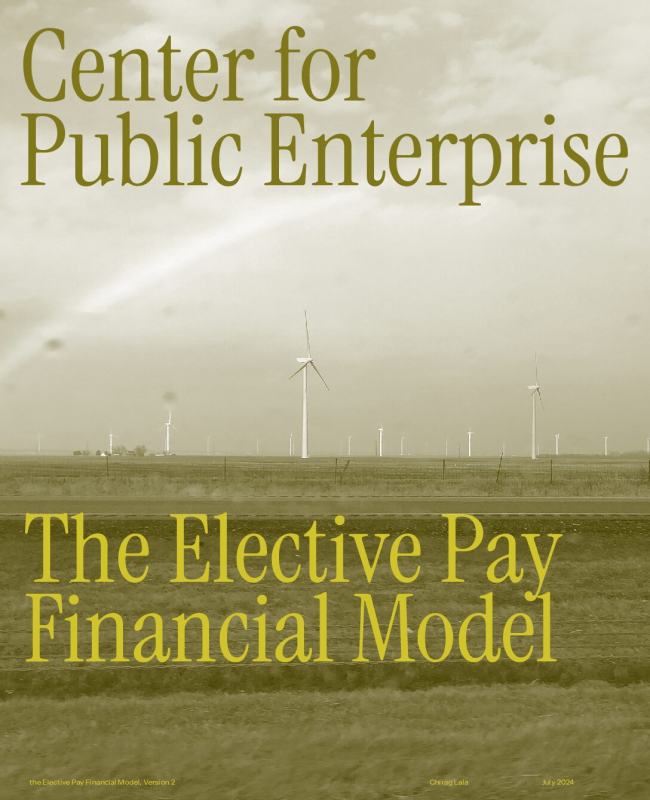In September 2023, Center for Public Enterprise (CPE) published the first iteration of the Elective Pay Model. The model is a free tool that allows users to analyze project-level financial considerations for state, municipal, or nonprofit projects claiming elective pay on either the investment or production tax credits, as well as any associated bonuses. The model was paired with a report describing the process of elective pay-eligible project development, the barriers to viability they face, and the policy interventions necessary to support public power development.
As of July 2024, CPE has published an update to the original model, along with an accompanying report. Here is a brief summary of the model’s new features:
- Expanded lists of model inputs, assumptions, and optionalities. These include insurance costs, bridge and term capital stacks with more diverse financing options, as well as direct inputs for capex costs. Modelers can also adjust financing strategies, such as the options to revolve out equity in the capital stack, require a higher debt service coverage ratio for viability, and set a flat risk factor on pricing for a PPA. The model also draws on 2024 Annual Technology Baseline data from NREL.
- Calculating consumers’ avoided cost. Modelers can now compare savings for hypothetical consumers of the project’s electricity by inputting in an “alternative” starting electricity price to that set by the model. The model will in-turn calculate period-to-period savings as well as an NPV of consumer savings. Modelers can also adjust the growth rates of both their electricity price and that of an alternative option available to consumers. This “avoided cost calculator” helps modelers approximate a grid planner’s gain from public renewable investment.
- Modeling ineligible provisions such as chaining or accelerated depreciation. There are two benefits that tax-liable projects (which cannot claim elective pay on the ITC and PTC) can access through using tax credits. The first is transferability, a provision through which projects can sell the rights to their future tax credit payment to another taxpayer in exchange for an upfront cash payment at a discount. The second is accelerated depreciation, a tax writeoff available to tax-liable energy projects via a five-year modified accelerated cost recovery system (MACRS) designed to account for obsolescence in capital investments. Modelers can now calculate the hypothetical benefit to their projects (elective pay or MACRS NPV) of allowing similar provisions to elective pay credits. Note that CPE made assumptions to enable such modeling. Transferability was modeled as “chaining” (in which recipients of a transfer can claim elective pay on a project whose progenitor was a nonprofit or state entity) with a fixed five percent discount on the total credit disbursement. MACRS was modeled as if each year’s deduction was paid to the project as a direct payment for five years—and can only be modeled for projects using ITC. To model either ineligible provision, modelers must select “YES” when asked to model policies not yet allowed. (CPE plans to file comments supporting a rule-change in favor of chaining.)
The purpose of these changes to our model was to enable policymakers and community developers to more realistically cost out the projects in their pipeline that could claim elective pay. We anticipate continued and periodic updates to this model based on new information, such as better data on market or technological changes, and to test creative financing or other policy strategies to facilitate the deployment of clean energy by the public and nonprofit sectors. The model’s “default” values are not intended to be authoritative or representative of available costs or technological information for particular geographies. They can be modified by the user. The model is intended to be iterative: given available information, policymakers should use it to guide their thinking about project development and gauge the relative efficacy of policy, pricing, and other strategies to stabilize project development.
The updated report describes how our model works and the conclusions we can draw from using it. We encourage policymakers and analysts testing our model to check out the report to get a better sense of how we envision the project development process.
More About this Resource
Publisher: Center for Public Enterprise
Date: July 16, 2024
Type: Report
Sector(s): Other Climate
State(s): None
